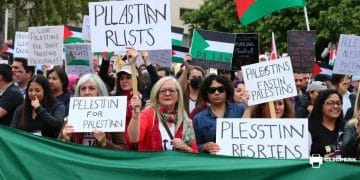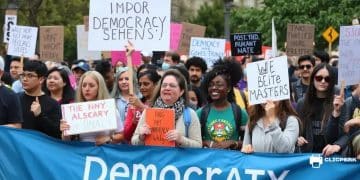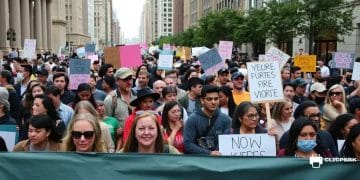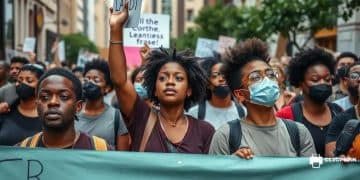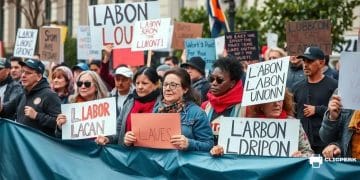LGBTQ+ rights demonstrations: celebrating voices and change

The future of LGBTQ+ advocacy and activism focuses on education, inclusivity, and leveraging technology to create a more equitable society, addressing pivotal issues like transgender rights and global equality.
In today’s world, LGBTQ+ rights demonstrations play a pivotal role in advocating for equality and acceptance. These events not only unite communities but also raise awareness about critical issues. So, what makes these gatherings so impactful?
The history of LGBTQ+ rights demonstrations
The history of LGBTQ+ rights demonstrations is rich and vibrant, reflecting the ongoing struggle for equality and recognition. These events have evolved significantly over the decades, making substantial impacts on both society and legislation.
In the early days, the movement was characterized by small, localized gatherings that aimed to challenge societal norms. One pivotal event was the Stonewall Riots of 1969, which served as a catalyst for the modern LGBTQ+ rights movement. This uprising marked a turning point, bringing visibility to the issues faced by the LGBTQ+ community.
Significant Milestones
Several significant milestones have shaped the landscape of LGBTQ+ rights demonstrations. Here are some key moments to remember:
- The first Pride marches in the 1970s, celebrating LGBTQ+ identities.
- Advancements in legal rights during the 1980s and 1990s.
- The fight against AIDS, which mobilized many activists.
- Recent demonstrations advocating for marriage equality and anti-discrimination laws.
As demonstrations grew larger and more organized, they began to attract widespread media attention. This visibility helped shine a light on the injustices the LGBTQ+ community faced. Large-scale events, such as the annual Pride parades, now draw millions of participants globally.
The Role of Activism
LGBTQ+ rights demonstrations have not only raised awareness but also led to tangible changes in laws and policies. Activists have worked tirelessly to lobby for equal rights, contributing to the repeal of discriminatory laws and the introduction of protective measures. The influence of these events is often seen in the legislation that follows. For example, the legalization of same-sex marriage in many countries was largely driven by the relentless advocacy stemming from these public demonstrations.
Today, events are more than just gatherings; they are celebrations of identity and community. Demonstrations serve as powerful reminders of the struggles that have come before and the ongoing fight for rights. Each event is filled with messages of love, acceptance, and a call for justice.
Key figures in the LGBTQ+ rights movement
The LGBTQ+ rights movement has been shaped by many influential figures who have fought for equality and justice. These individuals have played crucial roles in raising awareness and advocating for change, often at great personal risk.
One prominent figure is Marsha P. Johnson, a Black transgender activist who was a key player in the Stonewall Riots. Along with Sylvia Rivera, she helped to establish the Street Transvestite Action Revolutionaries (STAR), providing support for homeless transgender and LGBTQ+ youth.
Influential Activists
Numerous activists have influenced the course of LGBTQ+ rights demonstrations. Here are some who stand out:
- Harvey Milk – The first openly gay elected official in California, his legacy continues to inspire.
- Barbara Gittings – A pioneer in the fight against homosexuality being labeled as a mental disorder.
- Simon Nkoli – An anti-apartheid activist from South Africa who fought for LGBTQ+ rights.
- RuPaul – While primarily known as a cultural icon, he has played an essential role in bringing LGBTQ+ issues into mainstream media.
These activists have often used creative methods to engage the public and communicate their messages. For example, during the early activists’ efforts, the use of art and performance was a powerful way to raise awareness. They stood up not only to bring visibility but also to challenge the status quo.
The Impact of Their Work
Each of these LGBTQ+ rights movement figures has contributed to significant legal reforms and increased awareness of LGBTQ+ issues. Their efforts led to important changes, such as the decriminalization of homosexuality in several countries and the recognition of same-sex marriage in many jurisdictions.
Their stories inspire new generations to advocate for equality. Today, many LGBTQ+ events recognize these key figures, honoring their contributions through parades, awards, and educational programs. This ongoing recognition is vital in maintaining momentum in the fight for equality.
Impact of demonstrations on policy changes

The impact of demonstrations on policy changes related to LGBTQ+ rights is profound and far-reaching. Over the years, public demonstrations have not only raised awareness but have also sparked crucial changes in legislation and social attitudes.
For instance, one major outcome of these demonstrations has been the push for anti-discrimination laws. Many activists have taken to the streets to advocate for equal rights in employment, housing, and public accommodations. Their efforts have led to significant legal reforms in various regions.
Key Areas of Change
Some specific policy changes influenced by LGBTQ+ rights demonstrations include:
- The legalization of same-sex marriage in several countries.
- The repeal of discriminatory laws, such as the Defense of Marriage Act in the United States.
- Stronger protections against hate crimes targeting LGBTQ+ individuals.
- Inclusion of LGBTQ+ issues in anti-discrimination policies across various sectors.
Moreover, public pressure resulting from these demonstrations often compels lawmakers to act. Media coverage of events can shift public opinion, making it politically advantageous for legislators to support LGBTQ+ rights.
Case Studies of Success
Numerous successful campaigns highlight the effectiveness of demonstrations. For example, the 2015 Supreme Court ruling that legalized same-sex marriage in the United States was significantly influenced by years of protests and advocacy. Activist organizations organized rallies and events that educated the public and lobbied for legislative support.
In addition, the ongoing fight for transgender rights has gained momentum through rallies and awareness campaigns. Demonstrations focusing on issues like healthcare access for transgender individuals have pushed these topics into the limelight, prompting discussions at the legislative level.
How to participate in LGBTQ+ rights events
Participating in LGBTQ+ rights events is a meaningful way to show support for equality and acceptance. These gatherings, whether local or international, provide opportunities to connect with others and make your voice heard.
First, it’s essential to find events in your area. Many organizations host events such as Pride parades, rallies, and educational seminars. Websites and social media platforms often have information on upcoming events. Engaging with local LGBTQ+ groups can also help you stay informed.
Ways to Get Involved
Here are several ways to participate in LGBTQ+ rights events:
- Join a local LGBTQ+ organization to engage in advocacy and support.
- Volunteer during events to help with planning and logistics.
- Attend workshops and educational sessions to learn more about LGBTQ+ issues.
- Spread the word about events to your friends and family.
When attending events, it’s important to show respect and support for all participants. Be open-minded and willing to listen to the stories and experiences shared. Many events include speakers who share their journeys, offering valuable insights into the ongoing fight for rights.
Tips for Making the Most of Your Experience
To make the most of your time at LGBTQ+ rights events, consider the following tips:
- Dress comfortably and wear supportive shoes for outdoor events.
- Bring water and snacks to stay energized throughout the day.
- Engage with other attendees to learn and share experiences.
- Take photos, but always ask for permission before photographing others.
Every demonstration and event is a chance to advocate for change. Even if it’s your first time participating, your presence can have a powerful impact. Connecting with like-minded individuals will help foster community and solidarity, which is at the heart of the movement.
The future of LGBTQ+ advocacy and activism
The future of LGBTQ+ advocacy and activism looks promising as society becomes increasingly aware of the importance of equality and acceptance. As new generations engage in activism, they bring fresh ideas and perspectives that strengthen the movement.
One major trend is the use of technology in advocacy. Social media platforms have revolutionized how activists connect and mobilize support. Hashtags can spread awareness quickly, creating a powerful online presence for events and issues. With just a few clicks, people can share their stories and rally others to join the fight for rights.
Emerging Areas of Focus
As activism evolves, several key areas are becoming increasingly important:
- Transgender rights, including access to healthcare and protection against discrimination.
- Intersectionality, addressing the needs of LGBTQ+ people of color and those from different socio-economic backgrounds.
- Global LGBTQ+ rights, advocating for equality in countries where LGBTQ+ people face severe persecution.
- Climate justice as it intersects with LGBTQ+ issues, recognizing that marginalized groups are often disproportionately affected by environmental changes.
These focus areas highlight the growing understanding that advocacy must consider diverse experiences and challenges. By embracing these complexities, activists can foster a more inclusive movement.
The Role of Education
Education plays a crucial role in shaping the future of LGBTQ+ advocacy. Programs in schools and communities that promote understanding of LGBTQ+ issues can lessen stigma and discrimination. Workshops and seminars can educate the public on rights, history, and the ongoing challenges faced by the LGBTQ+ community.
Additionally, youth programs empower the next generation of activists. Young leaders can drive change by organizing events and advocating for their peers. Their energy and creativity are invaluable assets to the movement.
In conclusion, the future of LGBTQ+ advocacy and activism holds great promise as new voices continue to emerge. Emphasizing education, inclusivity, and the use of technology will shape the way forward. By focusing on essential areas such as transgender rights and intersectionality, activists can create a movement that empowers all. As we come together to support each other, we pave the way for a more inclusive and accepting society for everyone.
FAQ – Frequently Asked Questions about LGBTQ+ Advocacy and Activism
What are the main focuses of LGBTQ+ advocacy today?
The main focuses include transgender rights, intersectionality, global LGBTQ+ rights, and climate justice.
How can I get involved in LGBTQ+ rights events?
You can join local organizations, volunteer at events, and share information on social media.
Why is education important for LGBTQ+ advocacy?
Education helps reduce stigma and increases understanding of LGBTQ+ issues in society.
What role does technology play in modern activism?
Technology, especially social media, allows activists to mobilize support and raise awareness quickly and effectively.
